20+ Moments That Remind Us That Kindness Costs Nothing but Means Everything

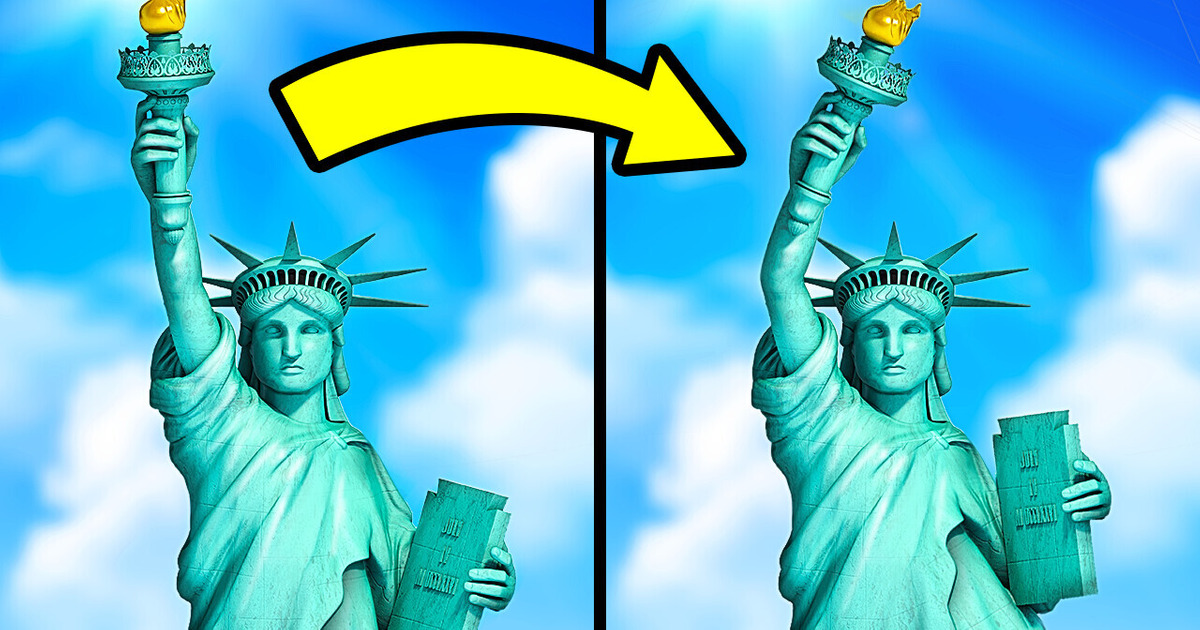
Although it’s tall and massive, the Statue of Liberty doesn’t always stand still. When the wind is strong enough, she sways by around 3 inches, and her torch — about twice as much. And then on calm days, if you look closely at her feet, you can sometimes catch her doing a little jig underneath that flowing robe. Nah, not really.
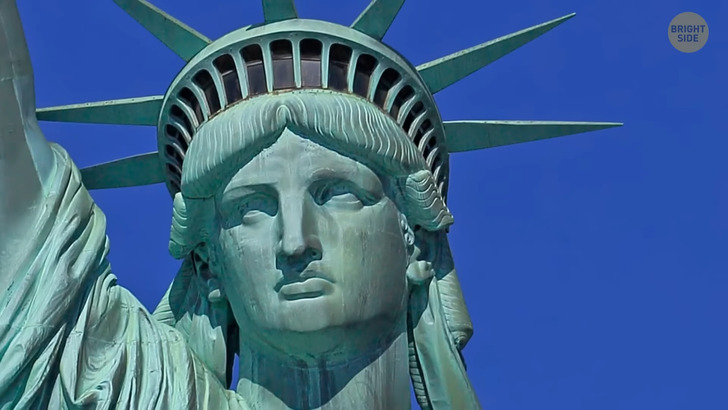
You know, there is more than one Statue of Liberty! A bronze replica of its little sister that served as a model for the NY statue stands in the Jardin du Luxembourg in Paris. A quarter-scale replica of the iconic monument is on an island in the Seine River, also in Paris. There is also a life-size gold-leaf-covered copy of the torch on the entrance to a world-famous tunnel in Paris.
Back in New York, if you look very closely at the face of Lady Liberty, you can clearly see that the famous statue was inspired by none other than the 50s pop star Elvis Presley... No, I’m just messing with you. The Statue of Liberty was designed by Frederic-Auguste Bartholdi 60 years before Elvis was even born. People have different opinions about who really inspired the face of Lady Liberty. According to one theory, the model for her was the beautiful Isabella Boyer. Isabella was born in 1841 to a wealthy family in Paris. When she turned 22, she moved to New York to marry an American entrepreneur and became a socialite. Yeah.
The real unglamorous story is Bartholdi modeled the face after his mother. Who, I guess Elvis looked like. Another theory that suggests that Lady Liberty might not be modeled after a western white woman as previously thought. As a young man, Bartholdi went on a trip to Egypt and after seeing the pyramids, he was inspired to create colossal sculptures. Older and more successful, Bartholdi returned to Egypt to propose a new sculpture at the entrance of the Suez Canal. The sculpture was to be called “Egypt Carrying the Light to Asia” and depicted a cloaked figure holding a torch to guide travelers through the canal. Well, that one cost too much, but he kept the idea in his head until another opportunity arose in New York Harbor.
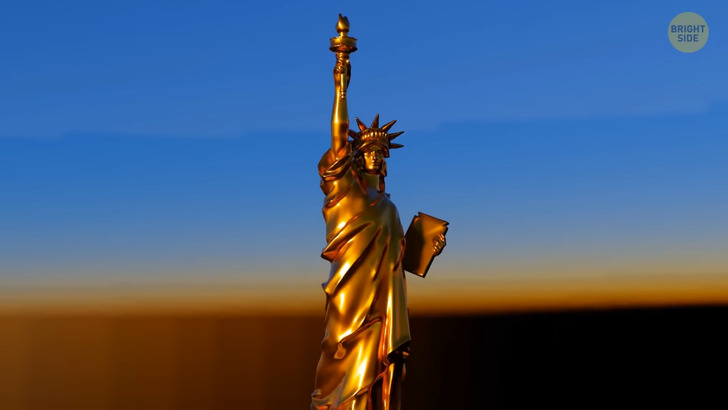
This is what this statue looked like 135 years ago. Yes, its color is very different. It’s the same color you’d see if you cut through an electrical wire. Because the entire outside of the statue is made of copper. About 20 years after it was installed, it turned completely green. That’s because the air and the frequent rains gradually oxidized the metal, called patina. And that metal is extremely thin. Designers could’ve made those sheets of metal thicker, but then the statue would’ve been even heavier, and it would’ve fallen under its own weight. A little thinner and the severe oxidation and corrosion of the metal would’ve made holes in the statue.
The sculptor had thought well about the construction of the statue, and it took more than 10 years to build it. But it all started with this model, made of clay. It was only 4 feet tall. So you would probably be taller than this mini Statue of Liberty, even with its arm raised. The next model was made of plaster. By increasing the size, the sculptor could add and refine the details of the statue. For example, a detail that you would never be able to see from Liberty island or even from the pedestal. It’s the shackles by her ankles. It looks as if she has thrown them off, symbolizing freedom.
The next model was 33 feet tall, or the length of a school bus. That’s about a quarter of the statue’s actual size. And it was the maximum size the sculptor could fit in his workshop. Then the sculptor proceeded to create the full-size pieces — the head and the hand holding the torch. The other hand held a stone tablet with Roman numerals embossed on it, signifying July 4, 1776, the date of American Independence.
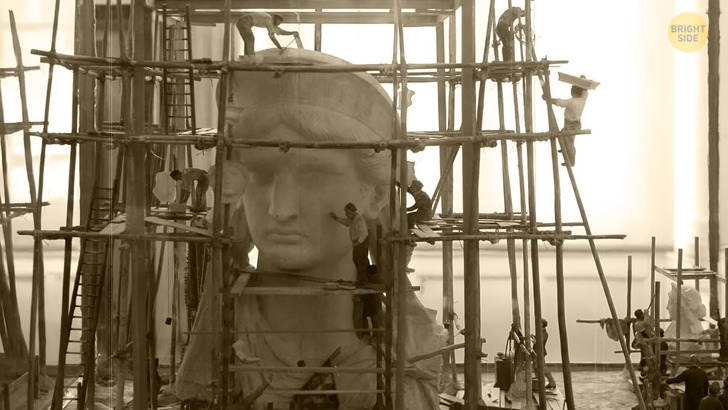
So it was time to build the final version of the Statue of Liberty. The constructors needed all the parts of the statue made of plaster first. Here’s its head. They took sheets of wood parallel to each other and pushed them against the model. The edges of the sheets were then shaped so that they perfectly replicated the shapes and curves of the statue. In other words, it was a mold. Then, the wooden structure was placed on the floor and covered with a sheet of copper the thickness of a penny. All that was left was to carefully shape the sheet of copper into the curves of the statue with soft wooden mallets and a press.
The statue and pedestal together cost $500,000 to build. French supporters raised funds to build the statue, and Americans paid for the pedestal it would stand on. In today’s money that would be over $10 million. The statue was completed in France and then shipped to America, packed in hundreds of wooden crates.
Over 200,000 Americans waited to greet the ship carrying Lady Liberty as it arrived in New York Harbor. The statue was assembled in four months on Bedloe’s Island which is now known as Liberty Island. A mistake might’ve been made when the Statue of Liberty was assembled. During an inspection in 1982, workers realized that her head had been installed two feet off-center.
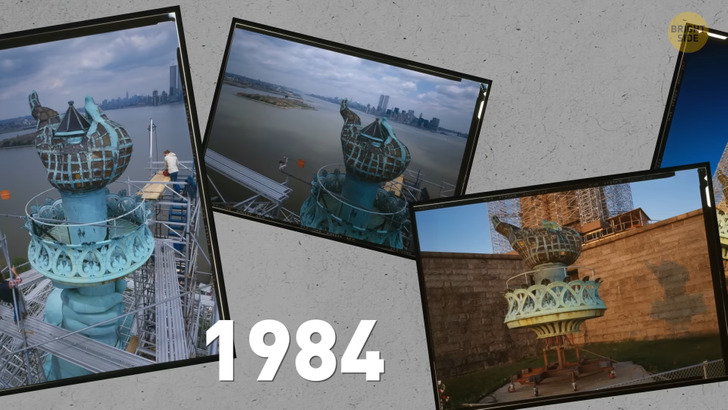
Shortly down the road in front of this famous Paris tunnel is the Flame of Liberty. This is a full-sized replica of the flame from Lady Liberty’s torch covered in gold leaf. This monument was gifted to France in 1989 by donors across the world as a thank you for the Statue of Liberty and as a symbol of the Franco-American friendship. About 4.5 million people visit the famous statue every year. By comparison, around 3.75 million people visit the London Eye each year. This makes the Statue of Liberty one of the most popular tourist attractions in the world.
Almost 100 years after the statue was erected, Lady Liberty’s torch was given a makeover. In 1984, the statue’s original copper and glass torch was replaced with a new one covered in 24-karat gold leaf. The torch is the only place not accessible to visitors due to damage it previously sustained, making it unsafe to climb up there.
The Statue of Liberty is 150 feet tall. It’s like 10 giraffes sitting on each other’s necks. Compared to the size of a person, you’d have to stand on the shoulders of your 25 friends to reach the torch in its right hand. The concrete base and pedestal make the statue even taller, 305 feet from the ground to the very top.
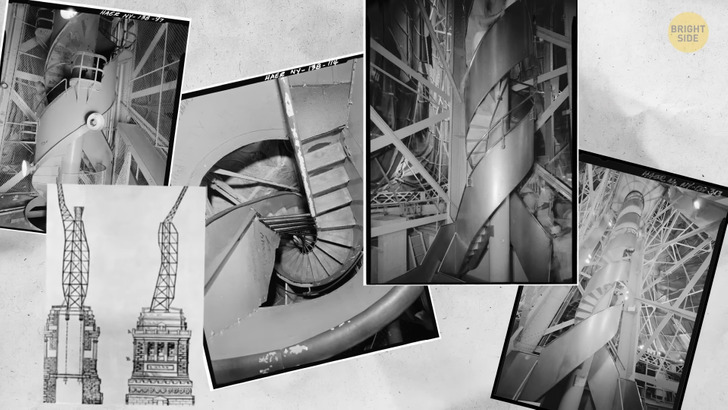
So, let’s get inside the thing. We have to go through the doors of a star-shaped base. Then you have a choice: take the elevator up to the observation deck or go up the 192 steps. You go first. There are stairs for tourists to go up and another staircase to go down to avoid the crowds and traffic. The stairs take you to the height of a six-story building, right up to the observation deck, at the top of the pedestal.
To get to the crown of the statue, we need to go to the 7th floor, where we see a double helix stairway. It runs right inside the iron pylons, the spine of the Statue of Liberty, designed by none other than Gustave Eiffel, you know, the Eiffel Tower guy. This stairway is double because there’s one side for going up and the other for going down. There’s also some space where you can rest if you get tired while going up. Yeah, I’ve done it, and yes you need it. And you need reservations.
As you climb the Statue, you can see exactly how the 300 copper sheets were attached to the metal frame. The story of how exactly they did that is riveting. Ha. And you can also distinguish specific details of the statue, like the folds of the dress and even locks of hair. 354 steps done, congratulations, you’ve reached the observation deck in the crown of the Statue of Liberty. It’s pretty cozy up there, and only fits a couple of people. You can peer out over New York Harbor through 25 glass windows. They symbolize the gems of our planet. And there are powerful lanterns behind you that light up the glass. They turn on at night, so that passing ships can see the Statue’s crown glow.
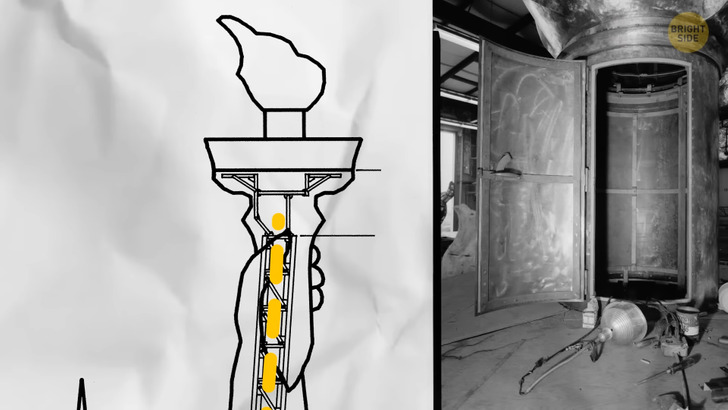
Entry to the torch is not allowed for tourists, but just for you, we’ll open it up for a minute. To get up there... you have to go down. Yes, about to the neck of the statue. There’s a hatch that leads through a narrow passage into the right arm of the statue. Then you have to go up the stairs to the wrist. And then another ladder will lead you to the handle of the torch.
Open the cylindrical door, and oh-my! You’re on the highest observation deck of the Statue of Liberty. For many years now, only workers have been allowed access here. Back at the beginning, this arm stood separately in Madison Square Park for 6 years to draw attention to that campaign until the funding issues were resolved.
And, before it even made it to the US, its head had been on display at the World’s Fair in Paris to help raise money for the project. The Statue’s lamp was to originally serve as a lighthouse beacon, but it was not bright enough (just like me) and the light could barely make it to Manhattan. Sculptor Bartholdi offered to cover the entire statue in gold to make it brighter. That idea would have been crazy expensive, so it was never brought to life. The original spikes above its head got rusty so what you see now was added way later.











